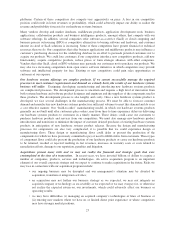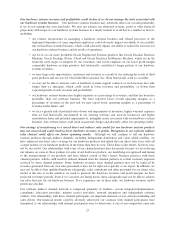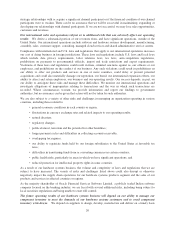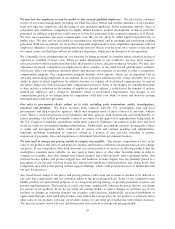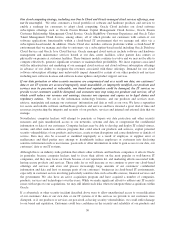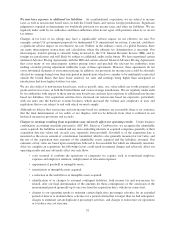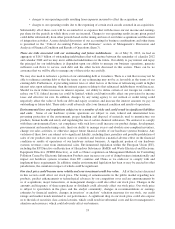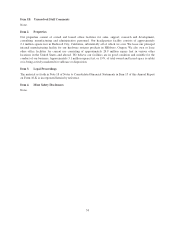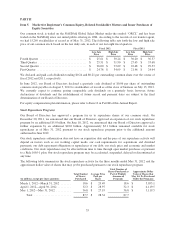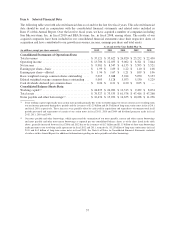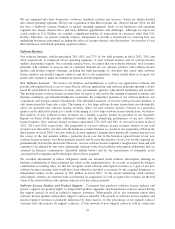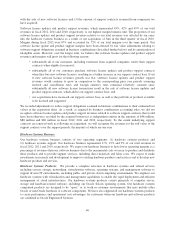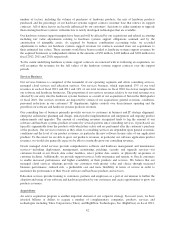Oracle 2012 Annual Report Download - page 37
Download and view the complete annual report
Please find page 37 of the 2012 Oracle annual report below. You can navigate through the pages in the report by either clicking on the pages listed below, or by using the keyword search tool below to find specific information within the annual report.• charges to our operating results resulting from expenses incurred to effect the acquisition; and
• charges to our operating results due to the expensing of certain stock awards assumed in an acquisition.
Substantially all of these costs will be accounted for as expenses that will decrease our net income and earnings
per share for the periods in which those costs are incurred. Charges to our operating results in any given period
could differ substantially from other periods based on the timing and size of our future acquisitions and the extent
of integration activities. A more detailed discussion of our accounting for business combinations and other items
is presented in the “Critical Accounting Policies and Estimates” section of Management’s Discussion and
Analysis of Financial Condition and Results of Operations (Item 7).
There are risks associated with our outstanding and future indebtedness. As of May 31, 2012, we had an
aggregate of $16.5 billion of outstanding indebtedness that will mature between the remainder of calendar 2012
and calendar 2040 and we may incur additional indebtedness in the future. Our ability to pay interest and repay
the principal for our indebtedness is dependent upon our ability to manage our business operations, generate
sufficient cash flows to service such debt and the other factors discussed in this section. There can be no
assurance that we will be able to manage any of these risks successfully.
We may also need to refinance a portion of our outstanding debt as it matures. There is a risk that we may not be
able to refinance existing debt or that the terms of any refinancing may not be as favorable as the terms of our
existing debt. Furthermore, if prevailing interest rates or other factors at the time of refinancing result in higher
interest rates upon refinancing, then the interest expense relating to that refinanced indebtedness would increase.
Should we incur future increases in interest expense, our ability to utilize certain of our foreign tax credits to
reduce our U.S. federal income tax could be limited, which could unfavorably affect our provision for income
taxes and effective tax rate. In addition, changes by any rating agency to our outlook or credit rating could
negatively affect the value of both our debt and equity securities and increase the interest amounts we pay on
outstanding or future debt. These risks could adversely affect our financial condition and results of operations.
Environmental laws and regulations subject us to a number of risks and could result in significant liabilities
and costs. Some of our hardware systems operations are subject to state, federal and international laws
governing protection of the environment, proper handling and disposal of materials used to manufacture our
products, human health and safety and regulating the use of certain chemical substances. We endeavor to comply
with these environmental laws, yet compliance with such laws could increase our product design, development,
procurement and manufacturing costs, limit our ability to manage excess and obsolete non-compliant inventory,
change our sales activities, or otherwise impact future financial results of our hardware systems business. Any
violation of these laws can subject us to significant liability, including fines, penalties and possible prohibition of
sales of our products into one or more states or countries and result in a material adverse effect on the financial
condition or results of operations of our hardware systems business. A significant portion of our hardware
systems revenues come from international sales. Environmental legislation within the European Union (EU),
including the EU Directive on Restriction of Hazardous Substances (RoHS) and Waste Electrical and Electronic
Equipment Directive (WEEE Directive), as well as China’s regulation on Management Methods for Controlling
Pollution Caused by Electronic Information Products may increase our cost of doing business internationally and
impact our hardware systems revenues from EU countries and China as we endeavor to comply with and
implement these requirements. In addition, similar environmental legislation has been or may be enacted in other
jurisdictions, the cumulative impact of which could be significant.
Our stock price could become more volatile and your investment could lose value. All of the factors discussed
in this section could affect our stock price. The timing of announcements in the public market regarding new
products, product enhancements or technological advances by our competitors or us and any announcements by
us of acquisitions, major transactions, or management changes could also affect our stock price. Changes in the
amounts and frequency of share repurchases or dividends could adversely affect our stock price. Our stock price
is subject to speculation in the press and the analyst community, changes in recommendations or earnings
estimates by financial analysts, changes in investors’ or analysts’ valuation measures for our stock, our credit
ratings and market trends unrelated to our performance. A significant drop in our stock price could also expose
us to the risk of securities class actions lawsuits, which could result in substantial costs and divert management’s
attention and resources, which could adversely affect our business.
33


